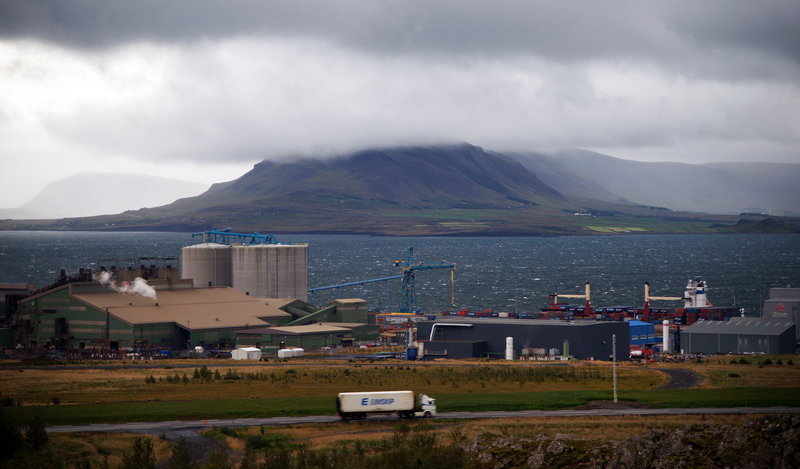REYKJAVIK, Iceland – With hopes for Maine manufacturers and the port of Portland riding on the success of an Icelandic shipping line, two state officials are here this week to build on Maine’s unlikely new partnership with this small island nation near the Arctic Circle.
John Henshaw, executive director of the Maine Port Authority, and Patrick Arnold, director of the authority’s operations and business development, will meet Friday with the board of directors of Eimskip, the shipping company that moved its North American headquarters this spring from Norfolk, Va., to Portland.
The two sides will discuss ways to improve operations at the International Marine Terminal in Portland, as Eimskip says it was promised, and how Maine’s new trading link with Europe can generate new U.S. customers for Eimskip and new export opportunities for businesses in New England.
So far, most of the trade is flowing from Iceland and mainland Europe to Portland in the form of commodities such as frozen fish, bottled water, lamb and an aluminum byproduct that’s used by U.S. manufacturers.
The new trading relationship – and the talks here this week – have high stakes for both Eimskip and Maine.
Maine officials want to encourage Eimskip to stay and keep investing in Portland. Besides benefiting the city, the revival of Portland’s historic cargo port would help Maine businesses by lowering their transportation costs and opening up new markets, Henshaw said.
Eimskip, meanwhile, needs Maine’s cooperation in developing the port, such as by extending rail service on the waterfront and obtaining land adjacent to the terminal so it can expand.
The company has said the steady supply of frozen fish it ships from Europe to Portland will encourage someone to build a cold storage warehouse in the city.
Eimskip also needs new American exporters to replace the customers it lost in the spring when it stopped calling on Norfolk and Everett, Mass., and made Portland its only port of call in the United States.
Eimskip officials say they are committed to investing in Portland for two years, with the intent of staying for many decades. Despite the loss of customers, they believe that the move to Portland creates more growth opportunities because their vessels save five days of sailing across the Atlantic, and Eimskip can provide more frequent and regular service.
Eimskip now offers biweekly service with two vessels, one that sails between Iceland and Portland and one that goes between Norway and Portland. Both vessels stop in Halifax, Nova Scotia, and Newfoundland.
The company’s goal is to make the port of Portland the U.S. gateway to the Arctic and sub-Arctic region, said Larus Isfeld, general manager for Eimskip USA.
For that to happen, Eimskip needs Maine’s help to improve operations at the Portland terminal, and Maine’s political leadership to develop U.S. policy on Arctic development issues, he said.
Isfeld said Mainers have become accustomed to looking west and south for opportunities and seeing the state’s position on the edge of the continent as an impediment.
“Maine always sees itself as being at the end of the road,” he said, “and nobody looks up north.”
Iceland, a nation of 320,000 people situated between North America and Europe, depends more on trade than most countries. As a result, many of its citizens see their country as being at the center of activity even though its isolated, Isfeld said.
Despite the company’s long-term vision, Eimskip officials have complained that it takes too long to load and unload ships in Portland, compared with other terminals that the company operates.
Eimskip officials also say they need rail access to the Portland terminal so cargo can be moved in and out by trains as well as trucks. Maine officials promised such rail access, Isfeld said.
State officials say they want to extend Pan Am Railways’ tracks about 1,500 feet from western Commercial Street. They have been negotiating for several months with landowners and the railway, without reaching a deal.
In Iceland this week, Henshaw and Arnold have been checking their email, hoping for good news on those negotiations to bring to Friday’s meeting with Eimskip.
The state officials have other good news for Eimskip. The biggest is that Gov. Paul LePage has dedicated $24 million from a proposed transportation bond for improvements to intermodal facilities such as the development on Portland’s waterfront.
Also, after Henshaw and Arnold toured the Eimskip terminal in Reykjavik this week, the Maine Port Authority decided to order a $500,000 reach stacker, a vehicle that moves shipping containers, with money from the state Department of Transportation.
The new, faster machine would replace a 13-year-old reach stacker at the International Marine Terminal.
On Wednesday at the Eimskip terminal, Arnold operated a reach stacker made in Sweden, the same model the state plans to buy.
When he climbed down from the vehicle, Arnold appeared excited.
“You can see how quick and efficient it is when we do have the right stuff,” he said.
Tom Bell can be contacted at 791-6369 or at:
tbell@pressherald.com
Send questions/comments to the editors.


